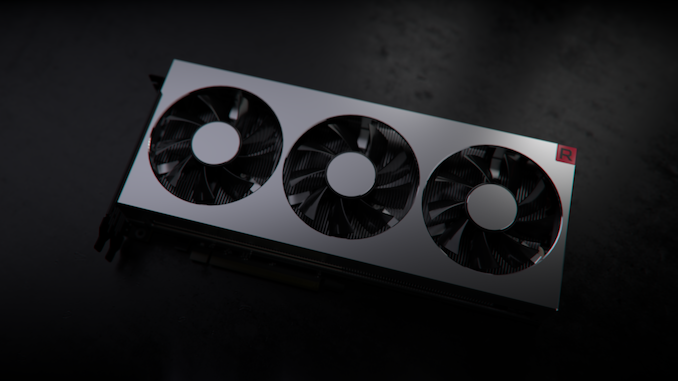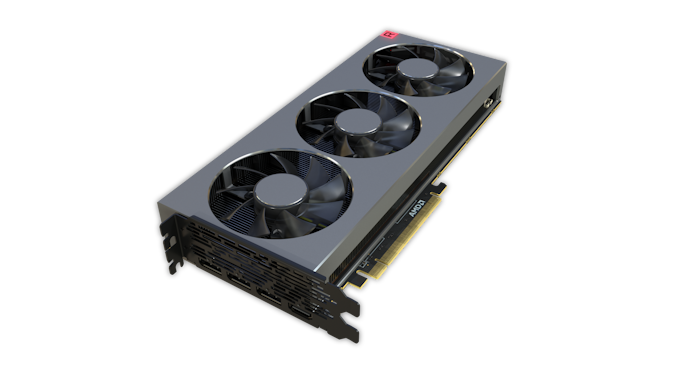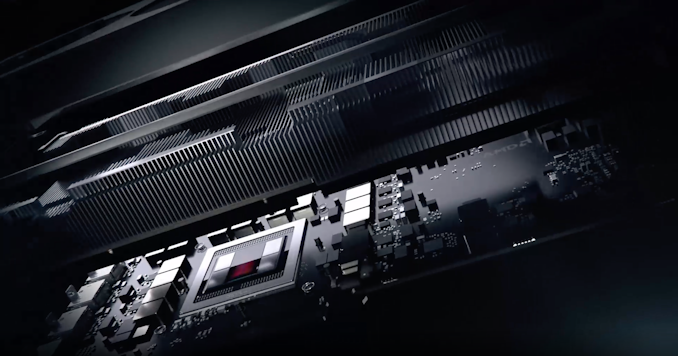The AMD Radeon VII Review: An Unexpected Shot At The High-End
by Nate Oh on February 7, 2019 9:00 AM ESTMeet The Radeon VII
First things first is the design and build, and for the AMD Radeon VII, we've already noticed the biggest change: an open air cooler. Keeping the sleek brushed metal look of the previous RX Vega 64 Limited Edition and Liquid variants, they've forgone the blower for a triple axial fan setup, the standard custom AIB configuration for high-end cards.
While NVIDIA's GeForce RTX series went this way with open-air dual-fan coolers, AMD is no stranger to changing things up themselves. Aside from the RX Vega 64 Liquid, the R9 Fury X's AIO CLC was also quite impressive for a reference design. But as we mentioned with the Founders Edition cards, moving away from blowers for open-air means adopting a cooling configuration that can no longer guarantee complete self-cooling. That is, cooling effectiveness won't be independent of chassis airflow, or lack thereof. This is usually an issue for large OEMs that configure machines assuming blower-style cards, but this is less the case for the highest-end cards, which for pre-builts tend to come from boutique system integrators.
The move to open-air does benefit higher TDP, and at 300W TBP the Radeon VII is indeed one for higher power consumption. While 5W more than the RX Vega 64, there's presumably more localized heat with two more HBM2 stacks, plus the fact that the same amount of power is being consumed but on a smaller die area. And at 300W TBP, this would mean that all power-savings from the smaller process were re-invested into performance. If higher clockspeeds are where the Radeon VII is bringing the majority of its speedup over RX Vega 64, then there would be little alternative to abandoning the blower.
Returning to the Radeon VII build, then, the card naturally has dual 8-pin PCIe connectors, but lacks the BIOS switch of the RX Vega cards that toggled a lower-power BIOS. And with the customary LEDs, the 'Radeon' on the side lights up, as does the 'R' cube in the corner.
In terms of display outputs, there are no surprises here with 3x DisplayPort and 1x HDMI.
A few teardowns of the card elsewhere revealed a vapor chamber configuration with a thermal pad for the TIM, rather than the usual paste. While lower-performing in terms of heat transfer, we know that the RX Vega cards ended up having molded and unmolded package variants, requiring specific instructions to manufacturers on the matter. So this might be a way to head off potential ASIC height difference issues.














289 Comments
View All Comments
eva02langley - Thursday, February 7, 2019 - link
Love my 2400g, agree with an iGPU like that, however you will not make me believe that an HD 520 is "enough".My only GPUs that died were Nvidia ones... 3 in total. 0 AMD.
TheinsanegamerN - Thursday, February 7, 2019 - link
Read what he said again. "For majority 90+ % of people Integrated graphics are good enough for spreadsheets, internet and word processing"Guess what nearly every office laptop and desktop uses? If it wasnt "good enough" there would be a push for more powerful iGPUs in widespread circulation.
The basic intel iGPU if far mroe then enough to do office work, stream video, or normal workstation content. more powerful GPUs are only needed in specific circumstances.
eva02langley - Friday, February 8, 2019 - link
I know what he said and I know what he means... and I know he is painted Intel all over his body.And no, basic HD 520 is not enough, period. You can barely do office work and play videos.
If it was so true, the mobile market would not be the most lucrative for games/entertainment. As of now, a smart phone is having more GPU power than an HD520.
So basically, I am not agreeing at all.
AdhesiveTeflon - Friday, February 8, 2019 - link
We do plenty of CAD work and GIS functions with Intel's iGPUs, so what were you saying about them barely able to do office work and videos?We also have a lot more issues with AMD's mobile and professional cards than nVidia's.
Icehawk - Saturday, February 9, 2019 - link
Out of 500 PCs at my job a whopping two have video cards, they are random low ends ones purchased to add additional video ports for two stations that run quad monitors. Otherwise there is zero need for a dGPU.This is typical of the vast majority of businesses.
ksec - Thursday, February 7, 2019 - link
1. I believe there will be better drivers for VII, it was quite clear that there are many optimisation not done in time, although I don't know how long it will take. The new AMD seems to be quick to react though.2. What if AMD decided to release the MI60 VII at $899.
TheinsanegamerN - Thursday, February 7, 2019 - link
VII is the VEGA arch, with more ROPs. If AMD managed to leave that much performance on the table, they must be the most incompetent code writers in all of existence.The VEGA arch has long been optimized for, adding some ROPs isnt going to require much work to optimize for, and AMD has likely already done that.
ksec - Friday, February 8, 2019 - link
Optimisation are now nearly done on a per AAA game level. And more importantly not only the drivers but the game itself. Whether the developer are willing to optimise the game ( at the help of AMD ) will be another story.lcrotach - Thursday, February 7, 2019 - link
Nice to see AMD being competitive again. It's a pity they've priced the card so high in Europe that you can get a RTX 2080 for 100 euros less. At that price point they won't be selling many.Manch - Thursday, February 7, 2019 - link
Need to see the VAT free price.